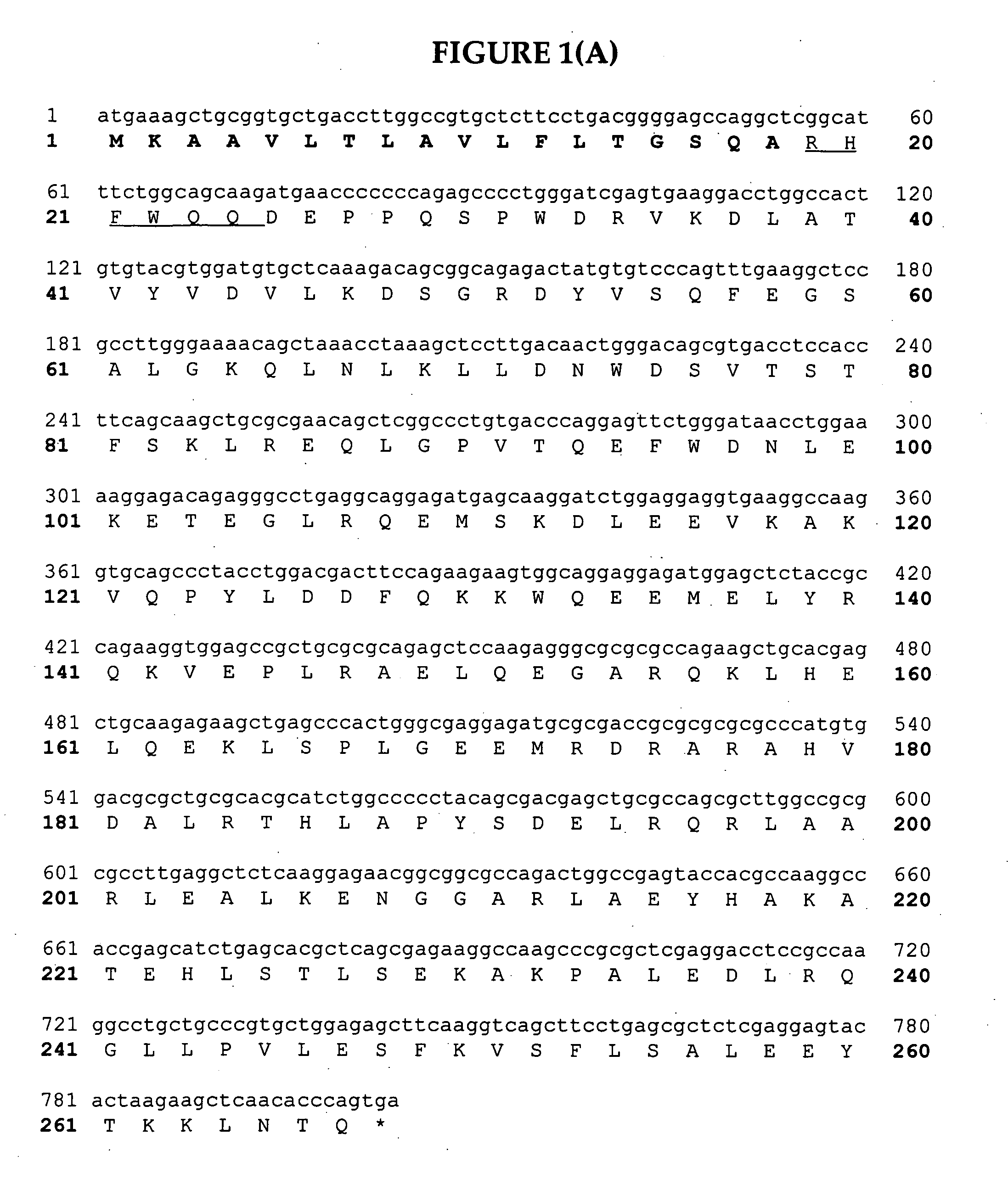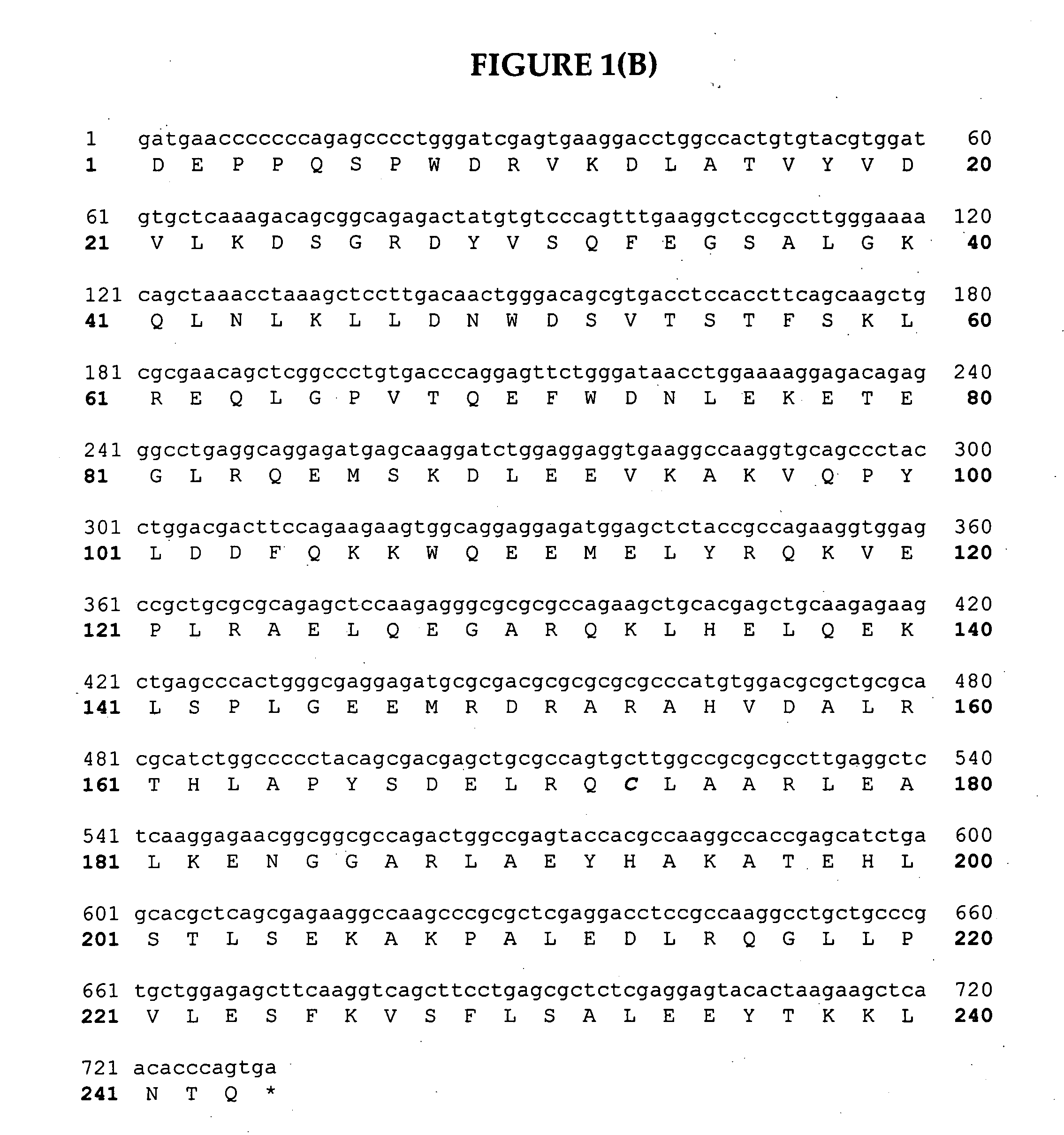Methods for the production of apolipoproteins in transgenic plants
a technology of apolipoprotein and transgenic plants, which is applied in the direction of peptide/protein ingredients, peptide sources, metabolic disorders, etc., can solve the problems of increasing cholesterol in the arteries, limited therapeutic use of apo ai and the apo ai-m mutant, and difficult recombinant production of apo ai
- Summary
- Abstract
- Description
- Claims
- Application Information
AI Technical Summary
Benefits of technology
Problems solved by technology
Method used
Image
Examples
example 1
Construction of Apolipoprotein A-I Clones
[0199] Apo10
[0200] Apo10 (SEQ ID NO:144) is a clone designed to express in a seed-specific manner which is constructed as per FIG. 3(A), 3(B) and 3(C). As seen in FIG. 2, the Apo10 clone consists of a seed-specific promoter and terminator (phaseolin) driving the expression of a fusion protein (SEQ ID NO:145) between mature Apo AI and GFP. To construct this clone forward primer 1186 (SEQ ID NO:146 (5′-GGATCCCCtTGGCTAGTAAAGG-3′) removed a NcoI site from the start of GFP (template derived from the vector pVS-GFP). Reverse primer 1187 (SEQ ID. NO:147) (5′-AAGCTTTCTAGACTGCAGTCATGACTTATTTGTATAGTTC-3′) added PstI, XbaI and HindIII sites after the stop codon. The PCR fragment was ligated into the EcoRI cloning vector Topo (Invitrogen) creating plasmid G1 (FIG. 3(A)). Forward primer 1190 (SEQ ID NO:148) (5′-CCATGGggCGGCATTTCTGGCAGCAAGATG-3′) amplifies the mature sequence of Apo AI and adds a NcoI site to the start of gene. Reverse primer 1189 (SEQ ...
example 2
Agrobacterium and Arabidopsis Transformation
[0278]Arabidopsis thaliana cv. Columbia (C24) is used for all the experiments. Seeds are planted on the surface of a soil mixture (two-thirds Redi-earth and one-third perlite with a pH=6.7) or an Arabidopsis soil mixture supplied by Lehle Seeds (perlite, vermiculite, peat, terra-green, with a pH=5.5) in 4 inch pots. The seedlings are allowed to grow to a rosette stage of 6-8 leaves to a diameter of approximately 2.5 cm. These seedlings are transplanted into 4 inch pots containing the above soil mixture, covered with window screen material which has five 1 cm diameter holes cut into the mesh; one in each of the corners, and one in the center. The pots are placed inside a dome at 4° C. for four days for a cold treatment and subsequently moved to 24° C. growth room with constant light at about 150 μE and 50% relative humidity. The plants are irrigated at 2-3 day interval and fertilized weekly with 1% of Peters 20-20-20. Each pot contains fiv...
example 3
Western Blot Analysis for Apolipoprotein Expression
Constitutive Expression
[0281] Apo17
[0282] As seen in Example 1, Apo17 (SEQ ID NO:27) is a fusion protein between mature Apo AI and GFP. An ubiquitin promoter and terminator are used for constitutive expression of the construct. Western blot analysis (FIG. 16(A)) using a polyclonal Apo AI antibody detected very low amounts (less than 0.1% of total leaf protein) the Apo-AI / GFP fusion protein in a total leaf extract at a molecular weight of approximately 55 kDa in 9 of the 12 clones. However substantial expression (at least 1% of total seed protein) of the Apo17 fusion protein was detected in a total seed extract (FIG. 16(B)) at approximately 55 kDa in 11 out of 12 clones tested.
[0283] Apo18a
[0284] As seen in Example 1, Apo18 (SEQ ID NO:29) is a fusion protein between pro-Apo AI and GFP. An ubiquitin promoter and terminator are used for expression of the construct. Western blot analysis (FIG. 17(A)) using a polyclonal Apo AI ant...
PUM
| Property | Measurement | Unit |
|---|---|---|
| Atomic weight | aaaaa | aaaaa |
| Composition | aaaaa | aaaaa |
| Nucleic acid sequence | aaaaa | aaaaa |
Abstract
Description
Claims
Application Information
 Login to View More
Login to View More - R&D
- Intellectual Property
- Life Sciences
- Materials
- Tech Scout
- Unparalleled Data Quality
- Higher Quality Content
- 60% Fewer Hallucinations
Browse by: Latest US Patents, China's latest patents, Technical Efficacy Thesaurus, Application Domain, Technology Topic, Popular Technical Reports.
© 2025 PatSnap. All rights reserved.Legal|Privacy policy|Modern Slavery Act Transparency Statement|Sitemap|About US| Contact US: help@patsnap.com



